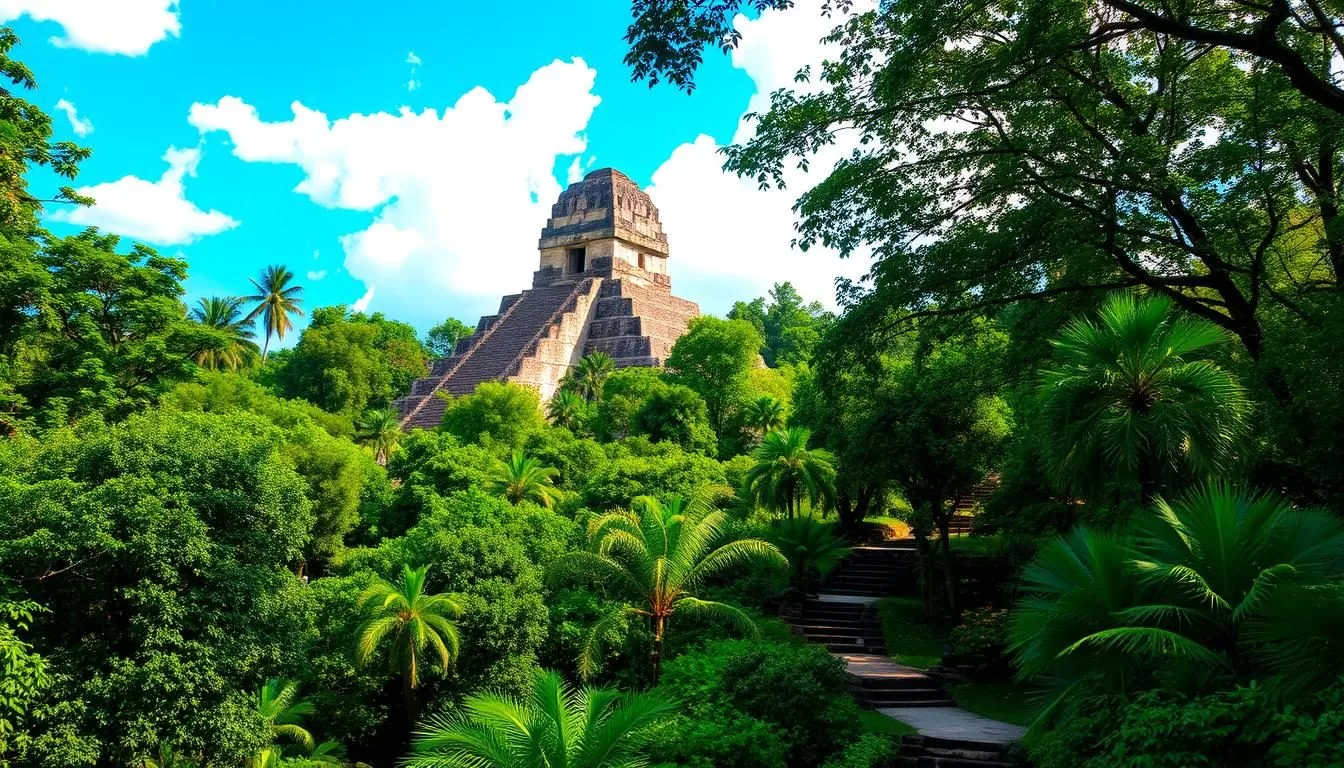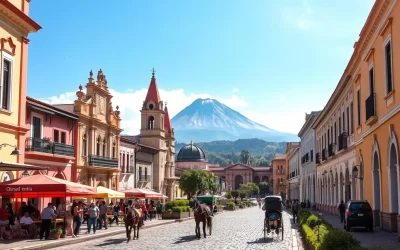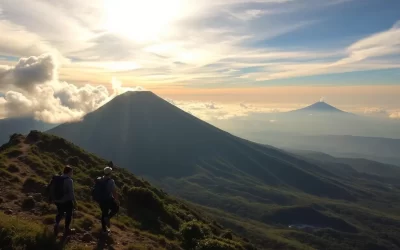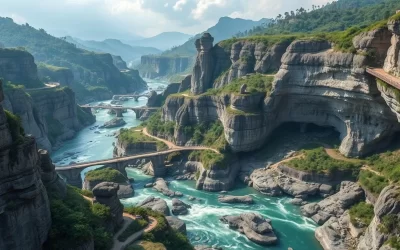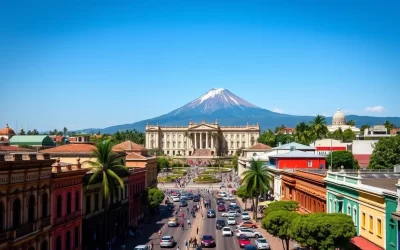✓ Accommodations✓ Flights✓ Rental Cars
Imagine walking through a lush jungle, surrounded by the sounds of exotic birds and animals, and stumbling upon ancient ruins that whisper tales of a long-lost civilization. Visiting Tikal is an adventure like no other, offering a unique blend of history, culture, and wildlife.
This UNESCO World Heritage Site was once the heart of the Mayan Empire, home to towering temples and pyramids hidden deep in the jungle. As you explore the ruins, you’ll have the opportunity to spot interesting wildlife, including coatimundis, spider monkeys, and deer, making your trip to this national park an unforgettable experience.
With so much to see and do, planning your day at Tikal can be overwhelming. That’s why we’ve put together this guide to help you make the most of your visit to this incredible place.
Discovering the Ancient Maya City of Tikal
Deep within the Guatemalan jungle lies Tikal, a testament to the grandeur of the ancient Maya civilization. As you explore this city, you’ll uncover a rich history that spans thousands of years.
Tikal was the capital of one of the most powerful kingdoms of the ancient Mayan Empire. The area was inhabited by the Maya as early as 900 BC, and the city reached its peak in the 8th century AD, boasting a population of up to 100,000 inhabitants.
The Historical Significance of Tikal
Tikal’s historical significance cannot be overstated. It was a major center of politics, economy, and culture in the Maya world. The city’s strategic location allowed it to control trade routes across Central America. At its height, Tikal was home to thousands of structures, many of which remain hidden beneath the jungle vegetation.
| Period | Event | Significance |
|---|---|---|
| 900 BC | Inhabitation by Maya | Early settlement |
| 8th century AD | Peak of Tikal | Maximum population and influence |
| 9th century AD | Decline of Tikal | Abandonment due to famine, droughts, and overpopulation |
What Makes Tikal Special
Tikal stands out among other Mayan ruins due to its remote jungle setting and remarkably well-preserved structures. The site offers a unique glimpse into the lives of the ancient Maya, with its temples, palaces, and plazas still intact.
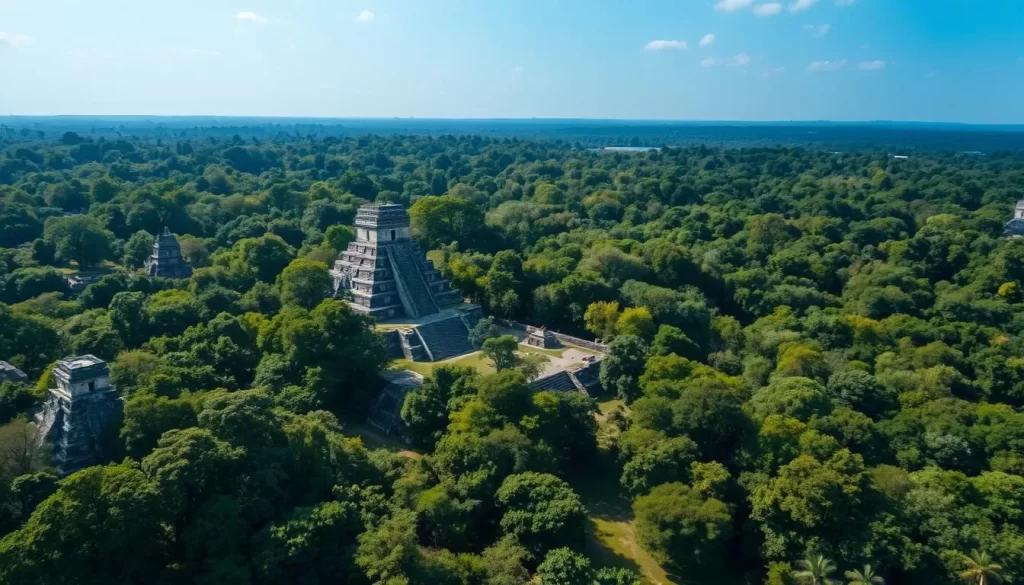
Only about 15% of Tikal has been excavated, leaving much to be discovered. As you explore Tikal, you’ll be struck by the sheer scale and majesty of this ancient city, hidden away for centuries.
Planning Your Visit to Tikal National Park
To make the most of your visit to Tikal, it’s essential to plan ahead. Understanding the best times to visit, the entrance fees, and how many days to spend in the park can significantly enhance your experience.
Best Time to Visit Tikal
The dry season, from November to April, offers the most reliable weather, making it the best time to visit Tikal. In contrast, the rainy season, which spans from May to October, brings daily showers that might impact your exploration plans. The park is open daily from 6am to 6pm, but if you’d like to stay until 8pm for sunset and nocturnal wildlife viewing, you need to get your admission ticket stamped.
Entrance Fees and Tickets
The entrance fee to Tikal National Park is 150 GTQ, approximately $20 USD. If you’re interested in visiting during sunrise or sunset, which are outside the park’s regular hours, you’ll need to purchase an additional ticket for 100 GTQ and be accompanied by a guide. Tickets can be bought online in advance, at Banrural banks throughout Guatemala, or at the park entrance.
| Ticket Type | Price (GTQ) | Price (USD) |
|---|---|---|
| Regular Admission | 150 | $20 |
| Sunrise/Sunset Access | 100 | $13 |
How Many Days to Spend in Tikal
While some visitors can see the highlights in a single day, spending two or more days in Tikal allows for a more thorough exploration of this vast archaeological site. The early morning and late afternoon are ideal times to visit the ruins, offering cooler temperatures and fewer crowds.
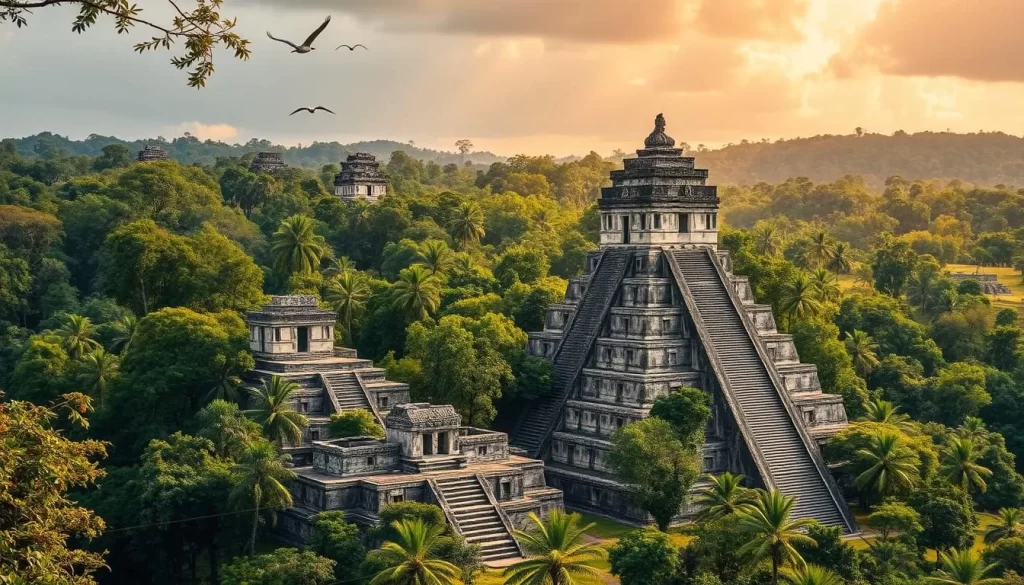
How to Get to Tikal, Guatemala
Reaching Tikal, a UNESCO World Heritage site, is easier than you think, despite its remote location in northern Guatemala. The journey involves two main legs: getting to Flores, the gateway town, and then traveling from Flores to Tikal National Park.
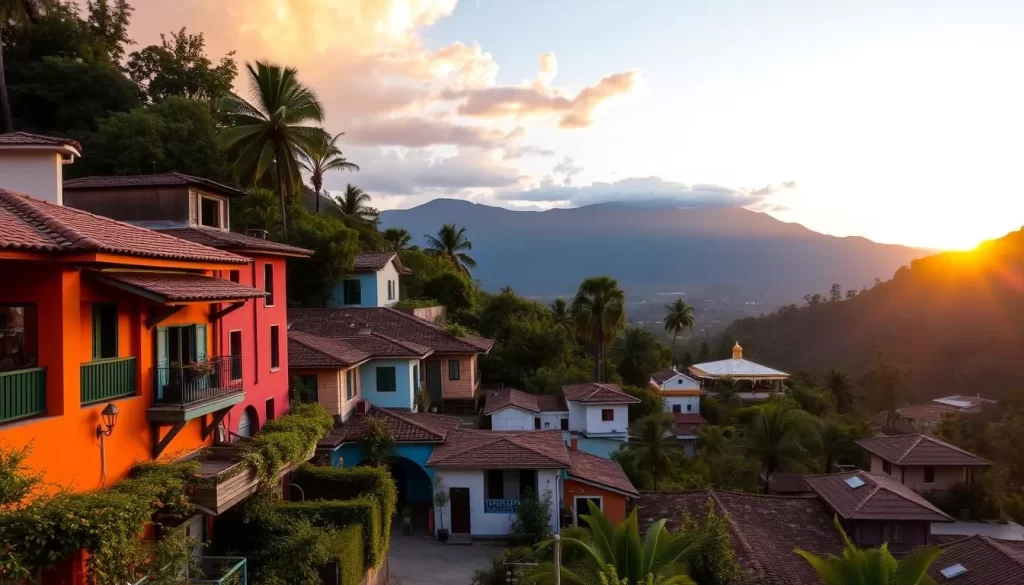
Getting to Flores
Flores is conveniently accessible by air, with Mundo Maya International Airport receiving multiple daily flights from Guatemala City. The flight is just one hour, making it a quick and efficient way to reach the region. Alternatively, you can drive or take a shuttle from Guatemala City or Antigua, though this takes around 9-12 hours.
Transportation from Flores to Tikal
From Flores, you have several options to get to Tikal: take a shuttle bus, join an organized tour, or drive yourself. Shuttle buses are a popular choice, costing around Q60 or $8 per person for a round trip. If you’re staying at a hotel within Tikal National Park, they can often arrange transportation for you, making the final leg of your journey hassle-free.
To get to Tikal, you can also consider booking a tour that includes transportation from Flores, providing a comprehensive and stress-free experience.
Top Things to Do in Tikal, Guatemala: Best Temples and Ruins
As you explore the ancient Mayan city of Tikal, you’ll discover a plethora of impressive temples and ruins that are sure to leave you in awe. Tikal is a treasure trove of Mayan history and architecture, with numerous structures and temples to explore. The site is dominated by the Gran Plaza, a majestic square surrounded by some of the most impressive structures, including Temple I and Temple II.
Gran Plaza and Temple I
The Gran Plaza is the heart of Tikal, surrounded by iconic landmarks such as Temple I, also known as the Temple of the Great Jaguar. This temple is a 47-meter tall pyramid that served as a tomb for King Jasaw Chan K’awiil I. You can explore the intricate carvings and steep staircase of Temple I, and visit the viewing platform on top of Temple II for spectacular views across the Gran Plaza.

Temple II, or the Temple of the Masks, is another notable landmark in the Gran Plaza, standing at 38 meters tall. The North and Central Acropolis are also worth exploring, featuring a maze of ruins, tombs, courtyards, and smaller temples.
Temple IV and Panoramic Views
For a truly unforgettable experience, visit Temple IV, the tallest temple in Tikal, standing at an impressive 70 meters. Climbing to the top of Temple IV offers breathtaking panoramic views of the jungle canopy, with numerous temples peeking above the trees. This is a must-do activity when visiting Tikal.
Mundo Perdido (Lost World) Complex
The Mundo Perdido, or Lost World Complex, is another top attraction in Tikal. This complex features the oldest pyramid in Tikal, as well as several other structures and twin pyramids. The Lost World Pyramid offers panoramic views from the top, making it a great spot to take in the surrounding landscape.
When exploring Tikal’s top temples and ruins, be sure to check which ones are open to visitors and plan your itinerary accordingly. With so many incredible structures to discover, you’re sure to have an unforgettable experience in this ancient Mayan city.
Sunrise and Sunset Tours: A Magical Experience
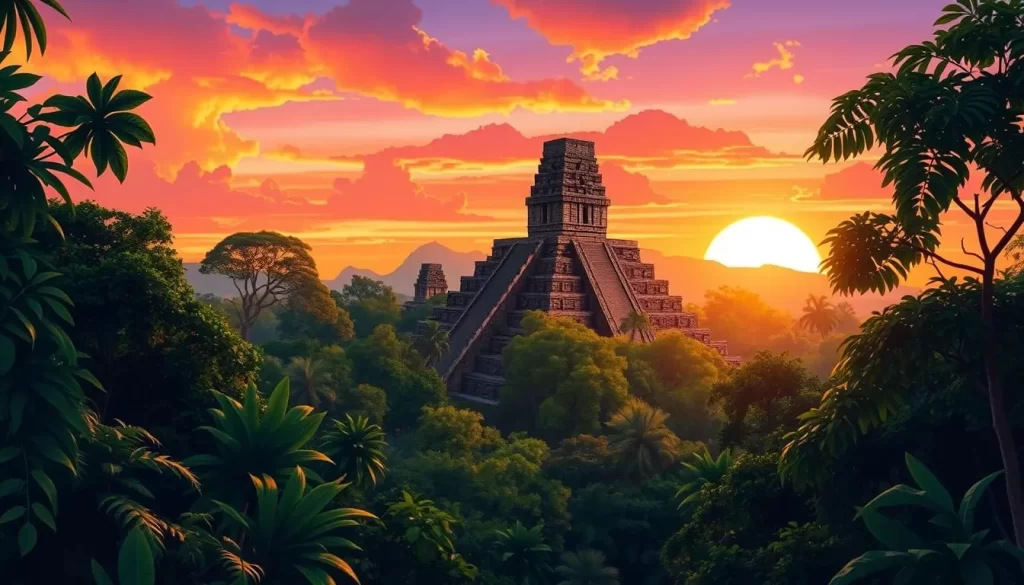
Experience the magic of Tikal at sunrise and sunset, when the ancient city’s mystique is heightened. Many visitors claim that these moments are truly unforgettable.
The sunrise tour is a unique experience that allows you to witness the jungle come alive. As you explore the ruins with a guide, you’ll be surrounded by the sounds of howler monkeys and birds calling in the early morning.
What to Expect on a Sunrise Tour
A typical sunrise tour begins around 3:00-4:00 AM with a guided walk through the dark jungle using flashlights. While the morning mist may obscure the actual sun, the experience of hearing the jungle wake up is truly unforgettable.
Sunset Tour Experience
In contrast, the sunset tour generally offers more reliable clear views and dramatic lighting as the sun sets behind Temple IV. This is a great opportunity to capture stunning photos and take in the breathtaking views.
To make the most of your tour, be sure to book with a reputable guide and plan ahead. Some tour operators, like San Juan Travel, offer special sunrise tours that include early access to the park and transportation from Flores.
Whether you choose to experience Tikal at sunrise or sunset, you’re sure to be left with lasting memories of this incredible ancient city.
Where to Stay When Visiting Tikal
Deciding where to stay when visiting Tikal can greatly impact your overall experience. You have two primary options to consider: staying in the town of Flores or within Tikal National Park itself.
Accommodation in Flores
Most visitors to Tikal stay in Flores, a town located 65 km (40 mi) from the ruins. Flores offers a wide range of accommodation options, from budget-friendly hostels like Los Amigos Hostel to mid-range hotels such as Hotel Isla de Flores, and luxury options like the stunning Bolontiku Boutique Hotel. When choosing to stay in Flores, you can expect a variety of amenities and services.
Staying Inside Tikal National Park
For a more immersive experience, consider staying inside Tikal National Park. There are three hotels to choose from, all within a short walk from the Tikal ruins. Jungle Lodge Tikal is a top choice, offering luxurious bungalows, a swimming pool, and a restaurant, nestled in the lush rainforest. Alternatively, you can opt for Hotel Tikal Inn or Hotel Jaguar Inn Tikal, which offer more rustic experiences. If you’re on a tight budget, camping is also an option near the park entrance for around 50 GTQ per person.
Staying inside the park allows you to enjoy early morning and evening access to the ruins when day-trippers have departed, making for a more serene and enchanting experience.
Essential Tips for an Unforgettable Tikal Experience
To make the most of your visit to Tikal National Park, consider these essential tips. Whenplanning your trip, pack light, breathable clothing and comfortable walking shoes to navigate the uneven terrain in the hot, humid jungle.
Don’t forget to bringessential itemslike water, snacks, sunscreen, and insect repellent. The jungle is home to variouswild animals, including howler monkeys, spider monkeys, and numerous bird species, so be prepared for wildlife encounters.
Hiring aguidecan enhance your experience, providing insights into the historical significance of thetemplesand helping you spot wildlife. Bring your passport or a copy, as it’s required for entry. Since cell service is limited, download maps before your visit.
Carrycashfor entrance fees, food, and souvenirs, as credit cards are not widely accepted. Allow enoughtimeto explore this vast ancient city; while you can see the highlights in one day, two or more days provide a more relaxed pace. Respect the site by staying on marked paths and taking all trash with you when you leave.
The above is subject to change.
Check back often to TRAVEL.COM for the latest travel tips and deals.
